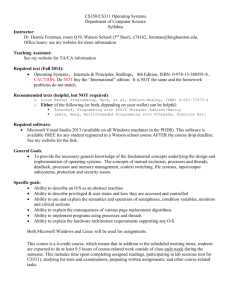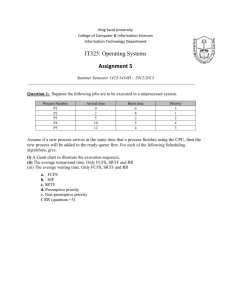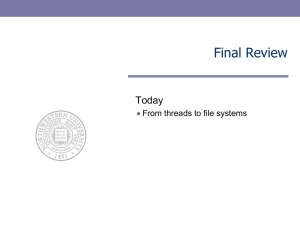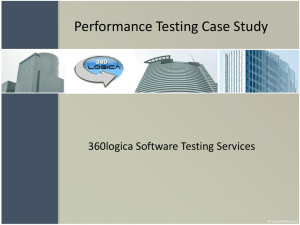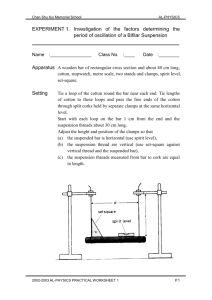Mutiple-Choice Quiz 6
advertisement
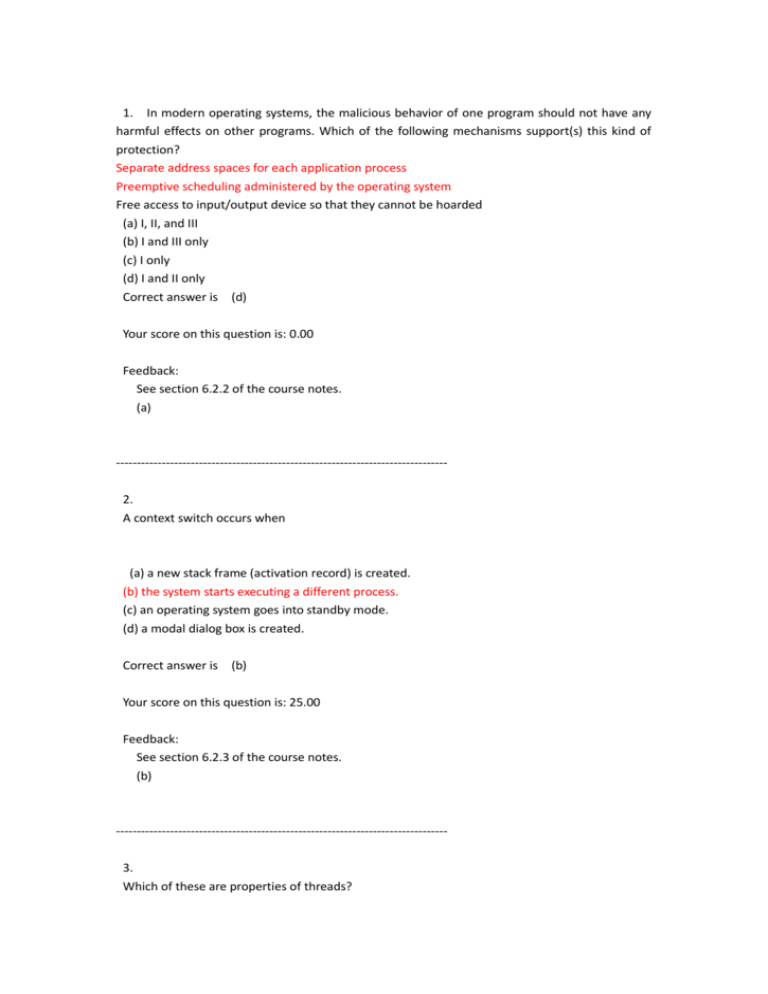
1. In modern operating systems, the malicious behavior of one program should not have any harmful effects on other programs. Which of the following mechanisms support(s) this kind of protection? Separate address spaces for each application process Preemptive scheduling administered by the operating system Free access to input/output device so that they cannot be hoarded (a) I, II, and III (b) I and III only (c) I only (d) I and II only Correct answer is (d) Your score on this question is: 0.00 Feedback: See section 6.2.2 of the course notes. (a) -------------------------------------------------------------------------------2. A context switch occurs when (a) a new stack frame (activation record) is created. (b) the system starts executing a different process. (c) an operating system goes into standby mode. (d) a modal dialog box is created. Correct answer is (b) Your score on this question is: 25.00 Feedback: See section 6.2.3 of the course notes. (b) -------------------------------------------------------------------------------3. Which of these are properties of threads? Only processes with special privileges can create threads. Threads eliminate the need to change address spaces in a context switch. Threads share memory. (a) I, II, and III (b) II and III only (c) II only (d) I and III only Correct answer is (b) Your score on this question is: 25.00 Feedback: See section 6.3.1 of the course notes. (b) -------------------------------------------------------------------------------4. A lock is a software mechanism that (a) prevents execution except in debug mode. (b) implements password protection to data. (c) temporarily makes memory read-only. (d) limits access to a critical section. Correct answer is (d) Your score on this question is: 25.00 Feedback: See section 6.3.4 of the course notes. (d) 1. To restrict access to an input/output device in a time-shared system, a program has to (a) map the device control registers into the application's address space. (b) execute special I/O instructions in the application's address space. (c) present the addresses of the device registers to the operating system. (d) make a system call through a trap instruction. Correct answer is (d) Your score on this question is: 25.00 Feedback: See section 6.2.2 of the course notes. (d) -------------------------------------------------------------------------------2. In modern operating systems, the malicious behavior of one program should not have any harmful effects on other programs. Which of the following mechanisms support(s) this kind of protection? Separate address spaces for each application process Preemptive scheduling administered by the operating system Free access to input/output device so that they cannot be hoarded (a) I and III only (b) I and II only (c) I, II, and III (d) I only Correct answer is (b) Your score on this question is: 25.00 Feedback: See section 6.2.2 of the course notes. (b) -------------------------------------------------------------------------------3. Priority inversion is a situation in which (a) long-running processes are assigned lower priorities. (b) a high-priority thread indirectly waits on a lower priority thread. (c) threads with the earliest deadlines receive higher priorities. (d) the scheduler reverses priorities to prevent starvation of low-priority threads. Correct answer is (b) Your score on this question is: 25.00 Feedback: See section 6.3.5 of the course notes. (b) -------------------------------------------------------------------------------4. Threads differ from processes in that threads (a) cannot make system calls. (b) exist only in the operating system kernel. (c) cannot be preempted. (d) share a single virtual address space. Correct answer is (d) Your score on this question is: 25.00 Feedback: See section 6.3.1 of the course notes. (d) 1. In modern operating systems, the malicious behavior of one program should not have any harmful effects on other programs. Which of the following mechanisms support(s) this kind of protection? Separate address spaces for each application process Preemptive scheduling administered by the operating system Free access to input/output device so that they cannot be hoarded (a) I only (b) I and III only (c) I and II only (d) I, II, and III Correct answer is (c) Your score on this question is: 25.00 Feedback: See section 6.2.2 of the course notes. (c) -------------------------------------------------------------------------------2. When a context switch occurs, (a) the contents of the cache are vital for performance. (b) the cache must be disabled. (c) the cache contents must be saved along with the processor registers. (d) the contents of the cache are mostly irrelevant. Correct answer is (d) Feedback: See section 6.2.3 of the course notes. (c) -------------------------------------------------------------------------------3. A lock is a software mechanism that (a) prevents execution except in debug mode. (b) implements password protection to data. (c) temporarily makes memory read-only. (d) limits access to a critical section. Correct answer is (d) Your score on this question is: 25.00 Feedback: See section 6.3.4 of the course notes. (d) -------------------------------------------------------------------------------- 4. Which of these are properties of threads? Only processes with special privileges can create threads. Threads eliminate the need to change address spaces in a context switch. Threads share memory. (a) II and III only (b) I, II, and III (c) II only (d) I and III only Correct answer is (a) Your score on this question is: 25.00 Feedback: See section 6.3.1 of the course notes. (a)


